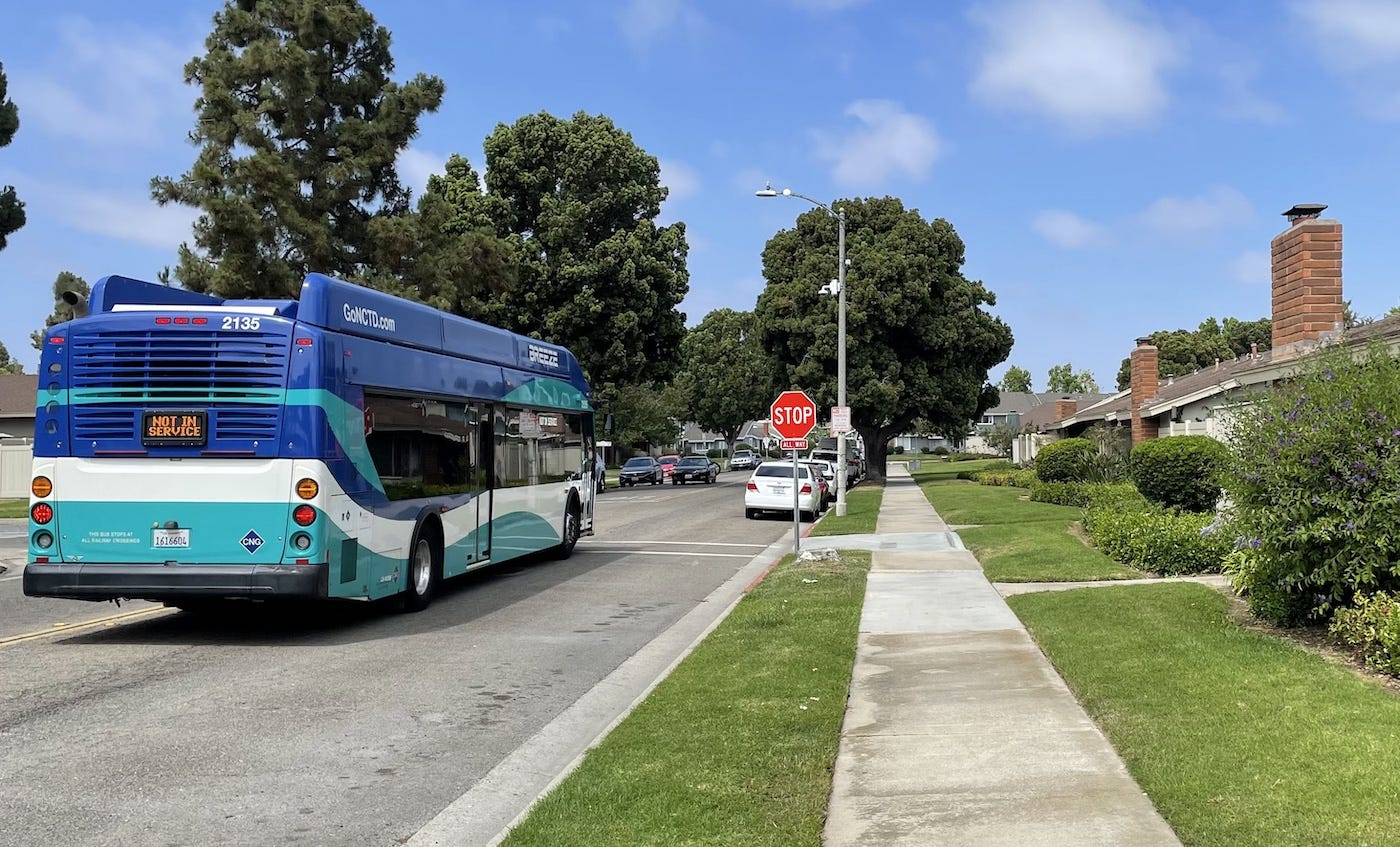STATE — One of the biggest battles in recent memory is ongoing in Sacramento over a bill proposing to dramatically reimagine housing development and single-family neighborhoods.
Senate Bill 79, authored by Sen. Scott Wiener (D-San Francisco), proposes to upzone land near all transit stops for multi-family housing, sets minimum heights at 55 feet and at least 80 units per acre. The bill also redefines “major” transit stop to include bus stops, even those in single-family neighborhoods.
Another provision is streamlining approvals through bypassing the authority of City Councils and Planning Commissions and “ensuring” affordability mainly by primarily developing near transit, according to the bill.
In Sacramento, meanwhile, a massive backlash has erupted from hundreds of cities, neighborhood and homeowner associations, and others, while dozens of YIMBY (Yes in My Backyard), cycling associations, and others are fiercely lobbying in support.
Locally, the cities of Carlsbad, Del Mar, Encinitas, Oceanside, San Marcos, mayors Dane White of Escondido and Lesa Heebner of Solana Beach and the San Diego Association of Governments are opposing the bill. In support are Circulate San Diego, San Diego Bike Coalition, Ride San Diego, YIMBY Democrats of San Diego and the city of San Diego, among others.
San Diego Mayor Todd Gloria and Assemblyman Chris Ward (D-San Diego) are under fire for the city’s support without public engagement or a City Council vote, according to the OB Rag. According to the story, Gloria unilaterally directing the city’s lobbyist to support SB 79. San Diego is just one of five cities to endorse the bill and the largest city to do so.
“First, SB 79 allows for upzoning land for multi-family homes up to 75 feet within a half mile of specified major train stations and bus rapid transit stops,” Wiener said in the bill’s comments. “This change will ensure that transit-oriented developments (TODs) are feasible and enhance access to transit. Second, SB 79 authorizes local transit agencies to develop on land they own. All TODs under SB 79 are eligible for the streamlined ministerial approvals process under SB 423 if they meet the law’s environmental, labor, and affordability standards.”
The bill, meanwhile, faced fierce bipartisan pushback on the State Senate floor on June 3 (video starts at the 6:50:20 mark) but passed 21-13. Seven Democrats, including Sen. Catherine Blakespear (D-Encinitas), voted against the bill with Republicans, while six Democrats didn’t vote.
On July 2, SB 79 passed the Assembly Housing and Community Development Committee, 9-2, and is with the Committee on Local Government, according to the State Legislature’s website.
What’s in the bill
Transit is central for the push to further densify infill housing across the state. The bill proposes three tiers of transit stops, which include all bus stops, along with requirements to consider rezoning residential, mixed-use and commercial zones.
However, the core of the law is Transit-Oriented Development (TOD), and SB 79 requires cities to respond by adopting default zoning standards near transit or proposing a compliant alternative TOD plan. The TOD allows housing within one-quarter to one-half mile of a “major transit stop,” which includes heavy rail, light rail, or ferry stations, and adds bus rapid transit (BRT) stations and high-frequency bus stops meeting state definitions.

Additionally, compliant projects within one of the three tiers are allowed to develop “by right,” meaning there is no discretionary review, downzoning and are exempt from the California Environmental Quality Act.
An alternative plan, meanwhile, must provide the same total housing capacity as SB 79 requires, cannot reduce one zone’s capacity or single site by more than 50%, be approved by the California Department of Housing and Community Development, and include fair housing and feasibility analyses. Cities not compliant will be referred to the Attorney General and could lead to a decertification of a city’s Housing Element and invoke Builder’s Remedy, which allows a developer to bypass all city standards.
SB 79 does the following:
Mandatory upzoning near transit
Overrides local zoning in conflict with SB 79 standards in TOD zones
Prohibits downzoning or lowering density in covered areas
Local TOD alternative plans allowed
No CEQA or discretionary review in TOD zones
Prohibits upzoning if existing renters are displaced
Prevailing wage and skilled and trained workforce requirements
Applies regardless of Housing Element compliance
Does not apply to industrial or environmental hazard zones
Does not require rent affordability provisions
Many of those opposing say allowing multi-family housing en masse will destroy single-family communities, many of which are master planned and developed decades ago. For example, a BRT stop counts as a qualifying “major transit stop” under SB 79.
It would allow a multifamily building up to 75 feet high at a density of 120 units per acre, or up to 65/100 within one-quarter or one-half mile of a BRT or a stop with “frequent” bus service. SB 79 defines the frequency as Tier 2 as service being every 15 minutes or less (more service) during peak hours (typically between 6-9 a.m. and 4-7 p.m.), while Tier 3 is “moderate” with service every 16-30 minutes.

Also, density is tied to floor area ratio (FAR), which is a metric defining how much buildable floor space is allowed on a parcel of land. So, a 10,000-square-foot lot with a FAR of 3 allows up to 30,000 square feet. Under SB 79, the minimum FAR is 3.5 for Tier 1, 3.0 for Tier 2 and 2.5-3.0 for Tier 3.
As for the bus stops, a preliminary analysis by North County Pipeline of North County Transit District’s Breeze routes shows no current area falling under Tier 2, but many are in Tier 3. However, once SANDAG rolls out its Rapid bus routes, many areas would qualify as Tier 2.
NCTD, meanwhile, has not taken a position on the bill.
“NCTD’s Board of Directors has not taken a position on SB 79; however, some jurisdictions within NCTD’s service area have voted to oppose the bill,” said Mary Dover, NCTD’s chief of staff. “NCTD is analyzing the bill’s most recent amendments to determine what the legislation could mean for housing near NCTD’s rail stations and high-frequency bus stops.”
Another caveat is homeowner’s associations. The analysis showed condominium HOAs are not exempt under SB 79, although a developer cannot build because of property rights and shared ownership structure.
A minimum of 67% of condo owners (in most cases) must agree to the development, or the developer or company must buy enough units to terminate the HOA. Single-family homes in a TOD zone, though, are treated like parcels in any other zoning lot and the HOA’s private land-use restrictions are legally unenforceable under SB 79.
Intense debate
Many supporters of the bill say the bill will help stabilize housing costs through the construction of more units. Additionally, supporters say more units address the state’s housing and climate crises through more units near transit.
Those factors, per supporters, will lead to an increase in ridership, reducing greenhouse gas emissions, and lower transportation costs. Also, supporters say it improves equity and enhances different modes of transportation.
Ian Hembree, SD Bike Coalition advocacy and community manager, said the SD Bike Coalition chose to support SB 79 because it promotes housing density and development in areas with investment in high-quality public transportation infrastructure. He said land use and transportation are intertwined as land use patterns influence travel demand and transportation infrastructure, while transportation accessibility affects land development and activity patterns, impacting everything from commute times to economic opportunities.
Hembree said cities embracing more mixed-use zoning will make cycling a viable transportation option for more people traveling to more nearby destinations. He said allowing amenities closer to where people live is essential for making cycling feasible and convenient.
“The bill enables increased housing production through density, which reduces housing costs, and allows people to leave their expensive car behind and take a bike or public transportation instead,” Hembree explained. “In these inflationary times, housing and transportation costs are increasing, and they make up the largest part of the household budget for most folks. These costs disproportionately affect communities that have seen discrimination in the past.”
On June 13, the SANDAG Executive Committee, chaired by Heebner, voted to oppose the bill, 4-1, with San Diego City Councilman Joe Lacava opposed. He supported the “opposed unless amended” option.
Lacava said he’s a YIMBY Democrat, but noted how San Diego’s upzoning and removal of height restrictions at the Morena corridor’s four transit stations hasn’t led to the development envisioned by the City Council. He said there are “structural” elements preventing development, but those issues are difficult so the legislature won’t act on those.
However, Heebner, Oceanside Mayor Esther Sanchez, and others ripped the bill as overreaching, as it will crush cities that already have plans in place and worked toward meeting housing goals, especially for low-income households, among others.
Heebner said one of the main problems with the bill is upzoning, which she said will only increase the value of land, thus setting new, and higher, rent levels. She said the bill ignores other factors going into “rational” planning, such as infrastructure, schools and open space.
Affordable housing, meanwhile, is not required under SB 79, Heebner said, which means market-rate or luxury units will be the outcome. She said there are no caveats for moderate housing development either. For example, Heebner said rents are up to $7,500 for a two-bedroom apartment and $6,000 for a one-bedroom in Solana Beach.
Heebner said TODs are already producing the opposite outcome when it comes to transit. She said several studies show residents in market-rate, or luxury, units are not using transit, as there has been a decrease in ridership. And those with multiple jobs or other responsibilities are not as likely to use transit as their main source of transportation.
Jones, meanwhile, said the proposed legislation could see a trade-off between homeownership and more renters. She said fewer people will own homes as many of the potential new projects will be rentals.
“We have all created certified Housing Elements because of that process,” she explained. “SB 79 ignores them, ignores all of them. This legislation takes land use authority from cities and gives it to transit agencies who have never had land use authority before, without allowing for any public engagement, without any environmental review, without compliance with the cities or county’s zoning standards or consideration for our state-certified Housing Elements.”
Sanchez, meanwhile, said Oceanside has been doing its part by updating its General Plan, increasing densities and exceeding its Regional Housing Needs Assessment numbers. She said the city is losing affordable housing because of previous changes to state laws and more market-rate units coming online, which are displacing Oceanside residents.
Sanchez said the city can do five or six stories in its urban core with 50 to 60 units, they can reach the requirements for affordable housing, but Oceanside would need more state money to reach those goals. She also worried about any amendments, as they would likely not address the concerns of many cities.
Sanchez said current laws allow unlimited waivers, while the Density Bonus Law allows for taller buildings and more units.
“We need to fight for local control,” she added. “We are very close to meeting our housing and economic goals. We will destroy South O. All of a sudden, everything will be seven stories. It will destroy the charm and character developed over time.”
White said he will bring the item before the City Council either this week or in the coming weeks to solicit a formal opposition stance.
Follow North County Pipeline on Instagram, Facebook, X and Reddit. Send story ideas and tips to ncpipeline760@gmail.com.














Share this post